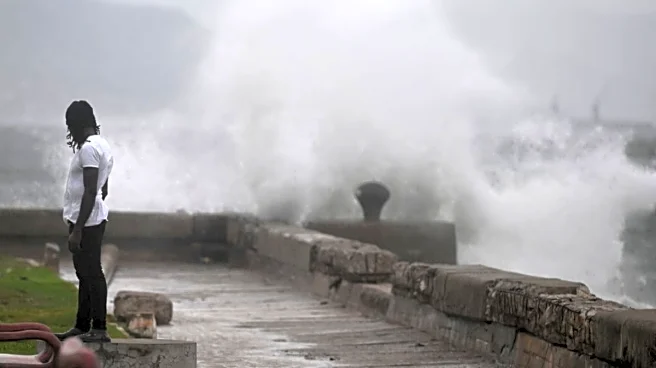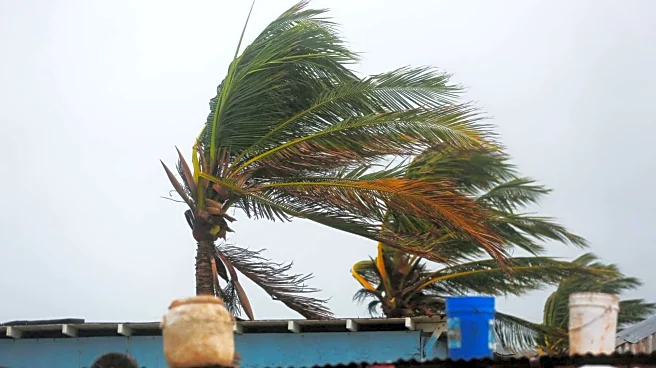Melissa crossed into Jamaica with sustained winds of 185 miles (298 kilometers) per hour — making it a rare Category 5 hurricane at landfall. It struck near New Hope on Jamaica’s southern coast, about 25 miles south of Montego Bay, the US National Hurricane Centre said in a statement at 1 p.m. New York time.
The storm is now a Category 3 on the five-step Saffir-Simpson scale with robust winds of 125 mph, the hurricane centre said at 8 p.m. Tuesday, New York time. It’s forecast to hit Cuba later as a major hurricane and then move through the Bahamas on Wednesday.
“Damaging winds will continue over portions of Jamaica this evening,” the NHC warned. “Catastrophic flash flooding and landslides are expected across the island tonight with widespread infrastructure damage, power and communication outages, and isolated communities.”
About 2,500 feet above sea level, Melissa’s winds clocked in at 215 mph, according to measurements collected by hurricane hunter aircraft before landfall. In addition to the winds, the storm has brought days of flooding rain, putting residents and an estimated 25,000 tourists on the island at risk.
Jamaica faces historic devastation, with local emergency managers ordering evacuations across the island and urging residents to stockpile drinking water for as long as three days. Authorities warned that the deadly weather conditions would also cause widespread damage to power and transport infrastructure.
The situation was still too chaotic to provide a full, official assessment, according to Minister of Local Government Desmond McKenzie, who has been leading the emergency response. He said the damage has been widespread.
“This is one of the worst experiences that we have ever encountered,” McKenzie said in a televised statement on Tuesday. More than 15,000 people are currently in shelters, while three hospitals have been severely damaged, requiring patients to be evacuated, he added.
The hurricane is expected to result in property damages costing between $5 billion and $10 billion, according to an estimate by Cotality, a property intelligence company.
Households and small businesses are more vulnerable than hotels, and gaps in insurance coverage could result in “severe financial and social disruption”, according to Firas Saleh, Director of Insurance Solutions for Moody’s.
Local media reported that Melissa was hammering St. Elizabeth Parish, along the island’s southwestern coast. Images shared by the Jamaica Observer showed roofs being ripped off buildings and streets covered in raging floodwater. In the capital, Kingston, there were reports of sporadic flooding and wind gusts tearing down billboards.
Jamaica’s Office of Disaster Preparedness and Emergency Management reported that roads in at least four parishes were blocked by trees and boulders, and a handful of bridges had been flooded out.
This is the strongest storm to hit land anywhere in the Atlantic since Hurricane Dorian struck the Bahamas in 2019, also with 185 mph winds, said Phil Klotzbach, a hurricane researcher at Colorado State University.
While the data is spotty in places, there is no record of a storm this strong ever hitting Jamaica since 1851, Klotzbach said. Before Melissa, the most powerful storm to hit the island was Gilbert in 1988, as a Category 4 with winds of about 132 mph.
Four Category 5 hurricanes have hit the US mainland, and only the Labour Day Hurricane of 1935 matched Melissa’s intense winds. The others, Camille in 1969, Andrew in 1992 and Michael in 2018, all lacked Melissa’s power, according to US National Oceanic and Atmospheric Administration records.
Read Also: Uber eyes fleet of 100,000 Nvidia-based robotaxis beginning 2027
/images/ppid_59c68470-image-176170506868424388.webp)

/images/ppid_59c68470-image-176161509921935026.webp)



/images/ppid_59c68470-image-176163008409919767.webp)
/images/ppid_59c68470-image-176165762288694387.webp)






